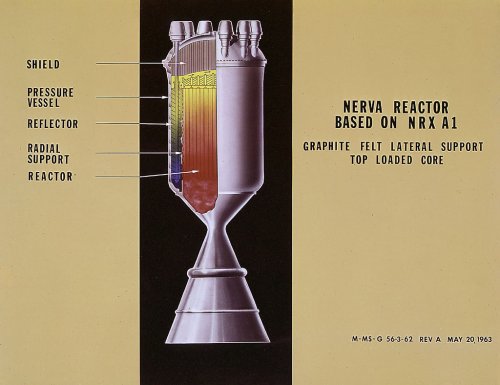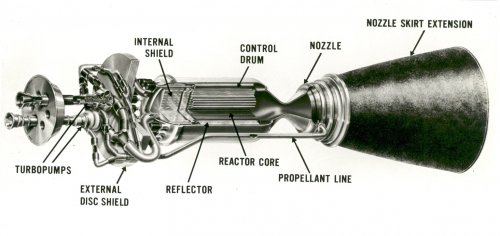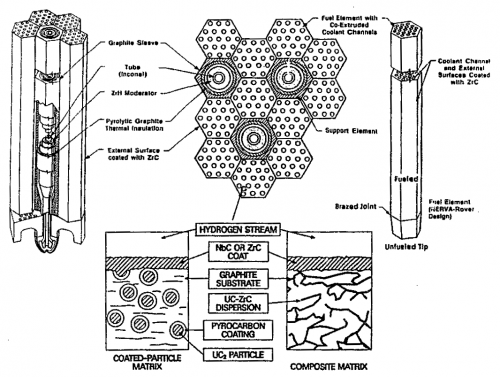You are using an out of date browser. It may not display this or other websites correctly.
You should upgrade or use an alternative browser.
You should upgrade or use an alternative browser.
NERVA - nuclear rocket
- Thread starter Orionblamblam
- Start date
- Joined
- 13 August 2007
- Messages
- 8,137
- Reaction score
- 9,894
my question to that grafik is
for several NERVA engine, was any danger of interaction of Neutron ?
i mean with Several engine under upperstage for NOVA and NEXUS booster
and Orbital use like Boeing IMIS 1968
for several NERVA engine, was any danger of interaction of Neutron ?
i mean with Several engine under upperstage for NOVA and NEXUS booster
and Orbital use like Boeing IMIS 1968
Clustering NERVAs was something that the designers spent a fair amount of time puzzling over. If you look at early designs, the engines tended to be fairly close. As time went by, they got further and further from each other... because they *would* interact. Most spacecraft designers, in the end, tried to reduce the number of nuclear engines as much as possible, with "one" being preferred.
A number of designs had NERVAs staged in series... one used for trans-Mars injection, say, another used to brake at Mars, another used to boost away from Mars, etc. At first glance this may seem silly... the NERVA was capable of running for *hours* and it both weighed and cost a lot, so it seems silly to throw so many away after using them for so short a time. But the reason for this was simple: prior to being turned on for the first time, the nuclear reactor is fairly "cold," radioactively. But once it's turned on and run at full power for a while, it becomes, and remains, dangerously radioactive. Thus there is wisdom in simply chucking the damend thing overboad and letting it drift many, many miles away once you're done with it, and firing up a new one when needed.
A number of designs had NERVAs staged in series... one used for trans-Mars injection, say, another used to brake at Mars, another used to boost away from Mars, etc. At first glance this may seem silly... the NERVA was capable of running for *hours* and it both weighed and cost a lot, so it seems silly to throw so many away after using them for so short a time. But the reason for this was simple: prior to being turned on for the first time, the nuclear reactor is fairly "cold," radioactively. But once it's turned on and run at full power for a while, it becomes, and remains, dangerously radioactive. Thus there is wisdom in simply chucking the damend thing overboad and letting it drift many, many miles away once you're done with it, and firing up a new one when needed.
Moderator: Add this "Space Projects" topic:
"NERVA, Aerojet, 1962"
http://www.secretprojects.co.uk/forum/index.php/topic,9487.0.html
"NERVA, Aerojet, 1962"
http://www.secretprojects.co.uk/forum/index.php/topic,9487.0.html
This artist's concept from 1963 shows a proposed NERVA (Nuclear Engine for Rocket Vehicle Application) incorporating the NRX-A1, the first NERVA-type cold flow reactor. The NERVA engine, based on Kiwi nuclear reactor technology, was intended to power a RIFT (Reactor-In-Flight-Test) nuclear stage, for which Marshall Space Flight Center had development responsibility.
Source:
http://mix.msfc.nasa.gov/abstracts.php?p=1812
Cutaway drawing of NERVA engine.
Source:
http://dubious-maxims.blogspot.com/
Radiation flux around a NERVA nuclear rocket engine from Nuclear Space Propulsion by Holmes F. Crouch.
http://www.projectrho.com/rocket/radiation.php
Cross-sectional view of fuel elements for the experimental NERVA reactor.
Source:
http://large.stanford.edu/courses/2011/ph241/hamerly1/
Source:
http://mix.msfc.nasa.gov/abstracts.php?p=1812
Cutaway drawing of NERVA engine.
Source:
http://dubious-maxims.blogspot.com/
Radiation flux around a NERVA nuclear rocket engine from Nuclear Space Propulsion by Holmes F. Crouch.
http://www.projectrho.com/rocket/radiation.php
Cross-sectional view of fuel elements for the experimental NERVA reactor.
Source:
http://large.stanford.edu/courses/2011/ph241/hamerly1/
Attachments
Movie on operation
http://www.criticalpast.com/video/65675039739_nuclear-reactors_nuclear-rocket-engine-system_nuclear-propulsion_hydrogen_nuclear-fission
criticalpast.com has lots of good things if you look.
http://www.criticalpast.com/video/65675039739_nuclear-reactors_nuclear-rocket-engine-system_nuclear-propulsion_hydrogen_nuclear-fission
criticalpast.com has lots of good things if you look.
Greetings, all.
NASA published an end-project report on Rover in 1991, though much of it appears to be a collection of earlier materials. Large-scale experiments (as in giant white-hot gas plumes in the desert) ended in (I think)1968, though some modest control and refinement work went on a few more years. Warning! runs to about 270 pages in PDF.
Report No. CR-184279 [internal file no. 313-002-91-059]; available from the NASA tech reports server: http://ntrs.nasa.gov/
LNAL (Los Alamos) explored nuclear-thermal rockets in the mid-1950's as well. The project was called "Dumbo" and used a very different (fissile impreg. refractory metal foil) core design.
Report No. LA-2091 [contract no. W-7405-Eng. 36] Feb. 21 1957
LNAL maintained an excellent archive of non- and de-classified materials for many years, but a lot of it has been removed out of an excess of Homeland silliness. You can try I guess. If you can't find it and just have to have all 400 blurry copy of a copy of a carbon pages, let me know, I'll see what I can do.
cheers, 5arg0n
NASA published an end-project report on Rover in 1991, though much of it appears to be a collection of earlier materials. Large-scale experiments (as in giant white-hot gas plumes in the desert) ended in (I think)1968, though some modest control and refinement work went on a few more years. Warning! runs to about 270 pages in PDF.
Report No. CR-184279 [internal file no. 313-002-91-059]; available from the NASA tech reports server: http://ntrs.nasa.gov/
LNAL (Los Alamos) explored nuclear-thermal rockets in the mid-1950's as well. The project was called "Dumbo" and used a very different (fissile impreg. refractory metal foil) core design.
Report No. LA-2091 [contract no. W-7405-Eng. 36] Feb. 21 1957
LNAL maintained an excellent archive of non- and de-classified materials for many years, but a lot of it has been removed out of an excess of Homeland silliness. You can try I guess. If you can't find it and just have to have all 400 blurry copy of a copy of a carbon pages, let me know, I'll see what I can do.
cheers, 5arg0n
- Joined
- 13 August 2007
- Messages
- 8,137
- Reaction score
- 9,894
here a Link to PDF version to Report No. LA-2091 "DUMBO" nuclear engine
http://www.dunnspace.com/00339489.pdf
http://www.dunnspace.com/00339489.pdf
- Joined
- 31 December 2006
- Messages
- 800
- Reaction score
- 358
NERVA historical overview circa 1991:
http://ntrs.nasa.gov/archive/nasa/casi.ntrs.nasa.gov/19910017902_1991017902.pdf
http://ntrs.nasa.gov/archive/nasa/casi.ntrs.nasa.gov/19910017902_1991017902.pdf
- Joined
- 13 August 2007
- Messages
- 8,137
- Reaction score
- 9,894
I found a in-deep report from 1991, It show all test Reactor used in Rover program
"Rover nuclear rocket engine program: Overview of rover engine tests"
9,7 MB PDF
http://ntrs.nasa.gov/search.jsp?R=19920005899&hterms=Nuclear+Furnace&qs=Ntx%3Dmode%2520matchallpartial%2520%26Ntk%3DAll%26N%3D0%26Ntt%3DNuclear%2520Furnace
http://hdl.handle.net/2060/19920005899
"Rover nuclear rocket engine program: Overview of rover engine tests"
9,7 MB PDF
http://ntrs.nasa.gov/search.jsp?R=19920005899&hterms=Nuclear+Furnace&qs=Ntx%3Dmode%2520matchallpartial%2520%26Ntk%3DAll%26N%3D0%26Ntt%3DNuclear%2520Furnace
http://hdl.handle.net/2060/19920005899
http://www.youtube.com/watch?v=WoiVej1rccs
- Joined
- 24 January 2006
- Messages
- 1,311
- Reaction score
- 433
Michel Van said:I found a in-deep report from 1991, It show all test Reactor used in Rover program
"Rover nuclear rocket engine program: Overview of rover engine tests"
9,7 MB PDF
http://ntrs.nasa.gov/search.jsp?R=19920005899&hterms=Nuclear+Furnace&qs=Ntx%3Dmode%2520matchallpartial%2520%26Ntk%3DAll%26N%3D0%26Ntt%3DNuclear%2520Furnace
http://hdl.handle.net/2060/19920005899
5arg0n said:NASA published an end-project report on Rover in 1991, though much of it appears to be a collection of earlier materials. Large-scale experiments (as in giant white-hot gas plumes in the desert) ended in (I think)1968, though some modest control and refinement work went on a few more years. Warning! runs to about 270 pages in PDF.
Report No. CR-184279 [internal file no. 313-002-91-059]; available from the NASA tech reports server: http://ntrs.nasa.gov/
Can anyone point me in the right direction to find either of these? I'm making a mess of things trying to get the damn NTRS search function to cooperate.
SOC said:Can anyone point me in the right direction to find either of these? I'm making a mess of things trying to get the damn NTRS search function to cooperate.
I'd hazard a guess these are not available on NTRS since it came back up. Whether or not these will ever be available there again, along with other documents remains TBD imo.
The video that Triton linked to is an interesting overview of the NERVA program. It also includes the best explanation for a rocket's specific impulse that I've seen yet. I've always felt the unit used (s) is odd, making it difficult to grasp what Isp indicates.
But as the video says, an Isp of 1 s means that one pound of propellant can supply 1 lb of thrust for one second. A real 'duh' moment for me
But as the video says, an Isp of 1 s means that one pound of propellant can supply 1 lb of thrust for one second. A real 'duh' moment for me
SOC said:Report No. CR-184279 [internal file no. 313-002-91-059]; available from the NASA tech reports server: http://ntrs.nasa.gov/
Can anyone point me in the right direction to find either of these? I'm making a mess of things trying to get the damn NTRS search function to cooperate.
It would appear to be available on the Wayback Machine, www.archive.org.
- Joined
- 3 June 2011
- Messages
- 18,043
- Reaction score
- 11,416
- Joined
- 9 October 2009
- Messages
- 21,278
- Reaction score
- 12,471
Nuclear Propulsion for Space Applications
- Joined
- 9 October 2009
- Messages
- 21,278
- Reaction score
- 12,471
- Joined
- 31 December 2006
- Messages
- 800
- Reaction score
- 358
Update on Area 25 Test Cell C and EMAD demolition:

 www.energy.gov
www.energy.gov

EM Nevada Meets 2023 Priority Cleanup Commitments Early
Nevada National Security Site (NNSS) completed a significant milestone demolition of four buildings at the Test Cell C (TCC) Facility at Area 25.
Scott Kenny
ACCESS: Above Top Secret
- Joined
- 15 May 2023
- Messages
- 9,834
- Reaction score
- 11,319
Yeah, Specific Impulse is a very non-intuitive unit.The video that Triton linked to is an interesting overview of the NERVA program. It also includes the best explanation for a rocket's specific impulse that I've seen yet. I've always felt the unit used (s) is odd, making it difficult to grasp what Isp indicates.
But as the video says, an Isp of 1 s means that one pound of propellant can supply 1 lb of thrust for one second. A real 'duh' moment for me
IMO, it's basically only useful for comparing very different rocket types to see which one is "better". And even then, you need to ask "better for what?" Because for surface launch, you want lots of propellant mass flow but you don't need that mass moving very fast (low Isp), but once you're up in orbit you can use a much smaller mass flow at higher speed (moderate to high Isp).
martinbayer
ACCESS: Top Secret
- Joined
- 6 January 2009
- Messages
- 3,083
- Reaction score
- 3,287
There's a reason why it's called rocket science. But don't fret, Mr. Tsiolkovsky can be your friend, if you let him...Yeah, Specific Impulse is a very non-intuitive unit.
IMO, it's basically only useful for comparing very different rocket types to see which one is "better". And even then, you need to ask "better for what?" Because for surface launch, you want lots of propellant mass flow but you don't need that mass moving very fast (low Isp), but once you're up in orbit you can use a much smaller mass flow at higher speed (moderate to high Isp).
Scott Kenny
ACCESS: Above Top Secret
- Joined
- 15 May 2023
- Messages
- 9,834
- Reaction score
- 11,319
Been too long since I needed to use calculus or even algebra, those equations make my head hurt these days.There's a reason why it's called rocket science. But don't fret, Mr. Tsiolkovsky can be your friend, if you let him...
- Joined
- 27 September 2006
- Messages
- 6,242
- Reaction score
- 6,458
Stephen Baxter wrote a fictional account of NERVA in this novel

 en.m.wikipedia.org
en.m.wikipedia.org
The engine seemed crucisl to Von Braun's ideas for a mars mission.

Voyage (novel) - Wikipedia
The engine seemed crucisl to Von Braun's ideas for a mars mission.
A recent article on the subject

 phys.org
phys.org

Nuclear rockets could travel to Mars in half the time, but designing the reactors that would power them isn't easy
NASA plans to send crewed missions to Mars over the next decade—but the 140 million-mile (225 million-kilometer) journey to the red planet could take several months to years round trip.
aonestudio
I really should change my personal text
- Joined
- 11 March 2018
- Messages
- 2,911
- Reaction score
- 7,233
Scott Kenny
ACCESS: Above Top Secret
- Joined
- 15 May 2023
- Messages
- 9,834
- Reaction score
- 11,319
I love the old school certificates like that!
martinbayer
ACCESS: Top Secret
- Joined
- 6 January 2009
- Messages
- 3,083
- Reaction score
- 3,287
As a tail end baby boomer, I truly appreciate the boundary pushing old school spirit behind open air tests like that. It was a simpler time...
Last edited:
Similar threads
-
A three way space race - with a twist (NASA vs AEC vs USAF)
- Started by Archibald
- Replies: 1
-
-
-
-





